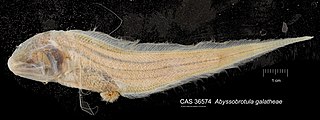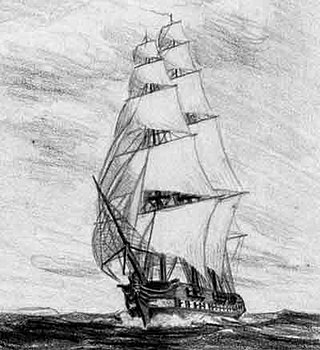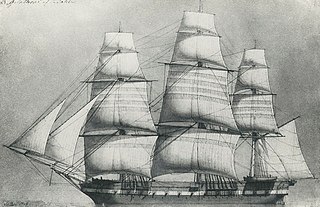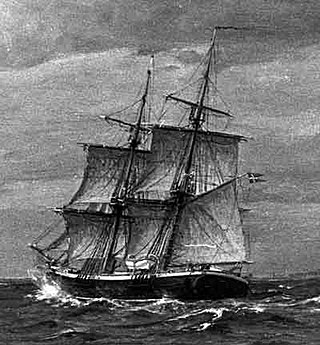
The Challenger expedition of 1872–1876 was a scientific programme that made many discoveries to lay the foundation of oceanography. The expedition was named after the naval vessel that undertook the trip, HMS Challenger.

The Royal Danish Navy is the sea-based branch of the Danish Defence force. The RDN is mainly responsible for maritime defence and maintaining the sovereignty of Danish territorial waters. Other tasks include surveillance, search and rescue, icebreaking, oil spill recovery and prevention as well as contributions to international tasks and forces.

Friedrich Benjamin Graf von Lütke, more commonly known by his Russian name Fyodor Litke, was a German-Russian navigator, geographer, and Arctic explorer. He became a count in 1866, and an admiral in 1855. He was a corresponding member (1829), Honorable Member (1855), and President (1864) of the Russian Academy of Science in St. Petersburg. He was also an Honorable Member of many other Russian and foreign scientific establishments, and a corresponding member of the French Academy of Science in Paris.

HDMS Vædderen (F359) is a Thetis-class ocean patrol vessel of the Royal Danish Navy. She is employed to exercise Danish sovereignty in waters around the Faroe Islands and Greenland.

The research ship had origins in the early voyages of exploration. By the time of James Cook's Endeavour, the essentials of what today we would call a research ship are clearly apparent. In 1766, the Royal Society hired Cook to travel to the Pacific Ocean to observe and record the transit of Venus across the Sun. The Endeavour was a sturdy boat, well designed and equipped for the ordeals she would face, and fitted out with facilities for her research personnel, Joseph Banks. And, as is common with contemporary research vessels, Endeavour carried out more than one kind of research, including comprehensive hydrographic survey work.

Abyssobrotula galatheae is a species of cusk eel in the family Ophidiidae. It is the deepest-living fish known; one specimen, trawled from a depth of 8,370 m (27,460 ft) in the Puerto Rico Trench in 1970, holds the record for the deepest fish ever captured. Although generally recognized, some have suggested that the record-breaking individual might have been caught with a non-closing net and therefore perhaps caught shallower.
Anton Frederik Bruun was a Danish oceanographer and ichthyologist.
The Emden Deep, also known as the Galathea Deep or Galathea Depth, is the portion of the 10,540-metre-deep (34,580 ft) Philippine Trench exceeding 6,000-metre (20,000 ft) depths in the south-western Pacific Ocean.
HDMS Narhvalen (S320) was the lead ship of her class of submarine for the Royal Danish Navy. She was built to the German Type 205 design at the naval dockyard in Copenhagen where she was laid down on 16 February 1965. She was launched on 10 September 1968, and was commissioned into the Royal Danish Navy on 27 February 1970. In 1994, Narhvalen and sister ship Nordkaperen were modified to bring their technical performance more in line with the Royal Danish Navy's newer Tumleren class. Narhvalen was decommissioned on 16 October 2003.

The Descubierta and Atrevida were twin corvettes of the Spanish Navy, custom-designed as identical special exploration and scientific research vessels. They were built at the same time for the Malaspina Expedition. Under the command of Alejandro Malaspina (Descubierta) and José de Bustamante y Guerra (Atrevida) the two vessels sailed from Spain to the Pacific Ocean, conducting a thorough examination of the internal politics of the American Spanish Empire and the Philippines. They explored the coast of Alaska and worked to reinforce Spain's claim to the Pacific Northwest in the aftermath of the Nootka Crisis. After crossing the Pacific Ocean, the colonial government in the Philippines was examined. Exploration and diplomatic reconnaissance followed, with stops in Qing dynasty-era China, New Zealand, Australia, and Tonga.

Dr. Hinrich Johannes Rink was a Danish geologist, one of the pioneers of glaciology, and the first accurate describer of the inland ice of Greenland. Rink, who first came to Greenland in 1848, spent 16 winters and 22 summers in the Arctic region, and became notable for Greenland's development. Becoming a Greenlandic scholar and administrator, he served as Royal Inspector of South Greenland and went on to become Director of the Royal Greenland Trading Department. With "Forstanderskaber", Rink introduced the first steps towards Greelandic home rule.

Steen Andersen Bille, was a Danish vice-admiral and minister for the navy. He was famous for his service in the Danish Royal Navy, particularly during the First Schleswig War, 1848–51.

HDMS Bellona was a frigate of the Royal Danish Navy, which she served from 1835 to 1862.

HDMS Galathea was a three-masted corvette of the Royal Danish Navy, constructed at Gammelholm to designs by Andreas Shifter in 1831. She is above all remembered for being the ship that undertook the First Galathea Expedition, 1845–1847. On two occasions, first in 1833 and later in 1839, Galathea was also instrumental in picking some of Bertel Thorvaldsen's artworks up in Rome and bringing them back to Denmark.

HDMS Ørnen was a brig build in 1842 for the Royal Danish Navy. Ørnen played important roles during the last years Denmark maintained the African colony Danish Guinea, and in the events leading up to the emancipation of the slaves on the Danish West Indies in 1849.

Seute Deern is a wooden, gaff-rigged ketch built as the cargo ship Havet in Svendborg, Denmark in 1939 for Captain Karl Lorenzen. Sold in 1956 to J. Lauritzen and renamed Noona Dan. Noona Dan circumnavigated the world in 1961/1962 on the Danish research cruise known as the Noona Dan expedition to the Western Pacific Ocean. After the expedition the ship was sold to Germany as a training ship, first owned and operated by Deutsche Schulschiff-Verein and 1973 by the German Clipper association. She continues to sail with young people on training cruises in the Baltic Sea. In winter the ship is moored at Hamburg-Harburg.

HDMS Det Store Bælt was a frigate of the Royal Dano-Norwegian Navy, launched in 1782. In 1800, she was sold to the Danish Asiatic Company and renamed Holsteen.

HDMS Justitia was a Royal Dano-Norwegian Navy ship-of-the-line, built to a design by Henrik Gerner. Although launched in 1777, she was not fully commissioned until 1780. The British Royal Navy seized her in 1807, together with the rest of the Danish fleet after the second battle of Copenhagen. The British never commissioned Justitia. A renaming to Orford in 1809 was cancelled. She was broken up in 1817.

HDMS Rota was a frigate of the Royal Danish Navy. She is above all remembered for being the ship that, in 1838, picked up the sculptor Bertel Thorvaldsen and many of his artworks in Livorno and brought them back to Denmark. Hans Dahlerup, her captain, and Alexander Wilde, then a junior lieutenant, have both described the voyage in their memoirs. In 1863, Rota was sold to H. Puggaard & Co. and converted into a civilian merchant ship. She wrecked off the coast of southern Norway in 1892, some ten years after being sold to Paul Larsen, Arendal.
Pseudoliparis belyaevi is a species of snailfish found in hadal zone of the Northwest Pacific Ocean, particularly the Japan Trench.


















